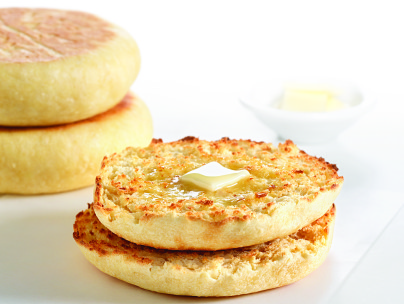In the great, wide world of breakfast breads, the English muffin is a well-known favorite. On sandwiches, under eggs Benedict, or on their own, English muffins are a classic choice for breakfasts on the go as well as leisurely Sunday brunches.
While English muffins may have cornered the breakfast market, however, they're not the only "European muffin" out there -- and they may not be the best either. The Portuguese muffin can one-up and out-do its English counterpart any morning of the week.
For those who aren't familiar with the Portuguese muffin, it is slightly sweeter and slightly larger than an English muffin. You don't pull it apart like you would an English muffin -- instead, you cut it in half with a knife, like you would a bagel. The cross-section is smoother, with fewer "nooks and crannies" than an English muffin.
The dough for Portuguese muffins consists of flour, sugar, eggs, butter, whole milk, yeast and water. See here for a recipe from Portuguese food blogger Tia Maria.
![portuguese muffin]()
Maria Dias
Also known as Portuguese sweet muffins, Portuguese sweet bread, Portuguese pancakes, or Bolo Levedo, these muffins are sturdier than English muffins and don't crumble as easily, which makes them great for sandwiches but also as stand-alone snacks.
![burger]()
Robyn Lee via Serious Eats
![grilled cheese]()
Robyn Lee
![portuguese muffins]()
King Arthur Flour
Popularized in the United States by Portuguese immigrants around New Bedord and Cape Cod in Massachusetts, these muffins can still be found in many a Cape Cod sandwich shop. Larger, chewier, slightly sweeter and more flavorful and substantial than an English muffin, it's no wonder they've caught on outside of Massachusetts too. While they're still not as ubiquitous English muffins, we think their time will come. Once you try one, you'll understand why they're seriously underrated.
Want to read more from HuffPost Taste? Follow us on Twitter, Facebook, Pinterest and Tumblr.
While English muffins may have cornered the breakfast market, however, they're not the only "European muffin" out there -- and they may not be the best either. The Portuguese muffin can one-up and out-do its English counterpart any morning of the week.
For those who aren't familiar with the Portuguese muffin, it is slightly sweeter and slightly larger than an English muffin. You don't pull it apart like you would an English muffin -- instead, you cut it in half with a knife, like you would a bagel. The cross-section is smoother, with fewer "nooks and crannies" than an English muffin.
The dough for Portuguese muffins consists of flour, sugar, eggs, butter, whole milk, yeast and water. See here for a recipe from Portuguese food blogger Tia Maria.

Also known as Portuguese sweet muffins, Portuguese sweet bread, Portuguese pancakes, or Bolo Levedo, these muffins are sturdier than English muffins and don't crumble as easily, which makes them great for sandwiches but also as stand-alone snacks.
Food writer Robyn Lee reports that New York's Zaitzeff serves an excellent burger on a Portuguese muffin. Unlike English muffins, Portuguese muffins can withstand the weight of a meaty patty with all the toppings, and their larger circumference makes a better fit.

They also make great grilled cheeses, as seen here in NYC restaurant Westville's gooey sandwich. The semi-sweet bread provides an awesome contrast to sharper cheese.

Their most perfect form may be the simplest, however: toasted with a pad of butter.

Popularized in the United States by Portuguese immigrants around New Bedord and Cape Cod in Massachusetts, these muffins can still be found in many a Cape Cod sandwich shop. Larger, chewier, slightly sweeter and more flavorful and substantial than an English muffin, it's no wonder they've caught on outside of Massachusetts too. While they're still not as ubiquitous English muffins, we think their time will come. Once you try one, you'll understand why they're seriously underrated.
Want to read more from HuffPost Taste? Follow us on Twitter, Facebook, Pinterest and Tumblr.